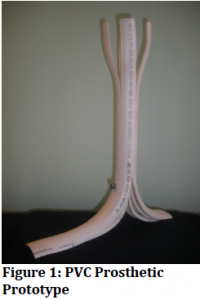Carl Ellingson
Background
The idea of this project was to research prosthetic leg designs in an effort to create a below-the-knee prosthetic device. The goal was to come up with a device that could be used in third world countries where the need is most considerable. In the past year we have come up with a design and are still in the process of testing the leg. We did not finish as fast as we would have liked, and we are still working on additional testing before we can present our idea to the scholarly community.
Past Research
Many important insights were gained through our research efforts, the most important being an in-depth understanding of the essential components of a prosthetic leg. First we focused on scholarly research to study past designs but then we found an even more fruitful way to learn about these replacement legs. Due the complexity of such devices, we found that some of the best information was attained by visiting a prosthetic clinic here in Provo. Lane Ferrin, the director and prosthetist at Northwest Orthopedics was very helpful in explaining the different components of a below-the-knee prosthetic leg. He was also kind enough to discuss a few ideas with us, pertaining to what would be feasible in a third-world country. Once we had figured out what was most important in creating an inexpensive design, we went to work to make a prototype.
Our Design
The main foot component is made out of different diameters of PVC pipe. By putting PVC pipe in a regular household oven and heating it up to 400 degrees, it becomes pliable for a few moments. After a few different designs, we settled on an idea where the PVC is cut down the center and two half circles bend in each direction to form the toe and the heel. By bending the PVC and then allowing it to cool, it becomes hard once again and serves as a spring. The two halves of the PVC become the hill-strike and toe spring action.

The other main part of the prosthetic leg is a socket wherein a below-the-knee amputee would place their residual limb. The primary structure of the socket component is the top half of a two liter bottle. We selected this everyday item to use as the socket because it is inexpensive, widely available, and relatively strong. By filing the socket with spray-foam and then placing a plaster stump mold matching the amputee’s limb, the foam forms to give the amputee a snug fit into the limb.
As far as attaching the leg to the amputee, we came up with both a leather strap as well as stretchable fabric. The leather strap simply attaches above the knee and keeps the leg from falling down while the stretchable fabric also serves with purpose but is more comfortable to the amputee. Leather is more readily available in the third world verses the stretchable material that would most likely have to be shipped in.
Again, we chose to use common materials for the different components of our leg to keep the cost down and be easily accessible to a large number of people. The other nice thing about using these simple materials is that if a piece of the leg was to break or if someone grew out of his or her leg, the components would be easily replaceable. The leg as we have it now cost between 10 and 15 dollars – a major accomplishment in itself when ones compares it to legs that are in the tens of thousands of dollars.
Plans for the Future
This project is not yet completed but has a promising future. With the help of BYU’s Instron machine we have started testing our leg to measure its durability and weight capacity. So far we have found that the leg can hold up to nine hundred pounds of vertical force and to pretty well as far as maintaining its rigidity after testing. The current hold-up with testing our leg is that we need to test the leg on a machine that can simulate a repeated vertical force to see how long the leg will last. To really find out the information that we need, the leg needs to be testing on a device that can simulate a million repetitions of vertical compressions. Such a testing device is not available at BYU so we are working with Dr. Colton, Dr. Bowden, and Dr. Pitt in our desire to find a testing facility that would be interested in donating their testing equipment and sponsor the leg. Currently, we are running a 100,000 cycle test on the leg at BYU to ensure it could take a greater cycle test at a professional testing facility here in Utah.
The other major step is to find a few amputees who would be willing to try out the leg for a significant amount of time to see how they like it. So far we have a few possible candidates who attend BYU and we are looking to find others who would be willing to offer their time.
Finally, we are excited about our plans to use our design as the basis for a social venture using the name:

Next semester we are planning to design a second prosthetic leg that would be more expensive. This design would include carbon fiber and other high-grade materials and would be for higher-income costumers.
